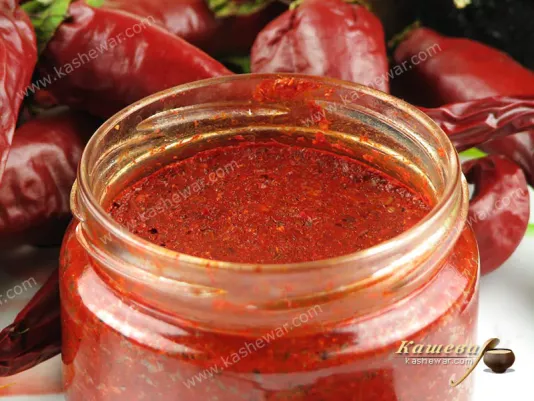Beef Tenderloin Rolls with Herbs
Beef tenderloin rolls with herbs - a recipe for Georgian cuisine, young potatoes can be served with the rolls.

Adjika is more than just a hot paste or spice blend – it's a true symbol of the flavor traditions of the Caucasus. I discovered real adjika during a culinary trip to Abkhazia, where it’s traditionally made at home – by hand in a mortar, using only natural ingredients. The foundation is hot pepper, mixed with garlic, salt, dried herbs (especially utskho-suneli), and sometimes nuts or a touch of cilantro. No trace of tomatoes, sugar, or vinegar – unlike the northern variants. I always keep adjika in my kitchen arsenal: it’s indispensable when I need to quickly add depth, intensity, and spicy character to a dish. I often use it as a meat marinade, a sauce base, or a flavorful highlight for fried vegetables or legumes. Real adjika is an ingredient that doesn’t compromise – and demands respect for its bold character.
Adjika has deep roots in Abkhazian and western Georgian cuisines, where it is not just seen as a “hot condiment,” but as a sacred element of culinary culture. In Abkhazian, the word "adjika" literally means "salt" – because salt is not merely an ingredient here but the foundation that preserves and enhances the flavor of all others. Traditionally, adjika was made as a thick paste: red or green hot peppers were ground together with plenty of garlic, salt, aromatic herbs, and spices – especially utskho-suneli, fenugreek, and sometimes ginger. There were no tomatoes, bell peppers, or vinegar – these additions appeared only when the recipe spread beyond the Caucasus. I deeply respect this tradition, so I always choose authentic paste – rich, spicy, with no excess moisture and the natural color of ripe peppers. This kind of adjika isn’t just a seasoning – it’s a language of flavor passed down through generations.
True paste-style adjika is a perfect example of how a few simple ingredients can produce a deep, multidimensional flavor profile. The core is always hot red pepper – freshly harvested, fleshy, and vibrant in both color and aroma. Garlic is added in generous amounts to bring pungency and its distinctive aftertaste. Salt serves not just for balance, but also as a natural preservative. I often use coarse sea salt, which not only preserves the paste well but also adds an appealing texture. Typical spices include utskho-suneli (wild blue fenugreek), coriander seeds, fenugreek, dried mint, sometimes walnuts or cumin. Proper adjika should never be runny or oily – its consistency should be thick and paste-like, with a bold aroma and a complex yet harmonious taste. I always taste adjika before using it to make sure the balance is right: it shouldn’t overwhelm the dish but rather reveal new flavor dimensions.
Adjika is a condiment that changes the entire course of cooking from the first spoonful. I regularly use it as a base for marinating meat: it works especially well with pork, lamb, chicken, and even game. Just coat the meat with a few spoonfuls of adjika, add a little oil – and let it sit for a few hours. The result is deeply flavored, tender meat with a flavorful crust after roasting or grilling. Adjika is also excellent in stews: I add it to vegetable ragouts, legumes, or meat sauces – either instead of tomato paste or alongside it. In pilaf, lobio, lentil soup, or even a basic potato casserole – it brings structure and richness everywhere. I also love to spread it on lavash before baking or pair it with brined cheese – the heat perfectly complements simple ingredients.
Adjika isn’t just for cooking – it also makes a perfect finishing accent for ready meals. I often serve it with grilled meats, kebabs, charred vegetables, or even fried eggs. In small amounts, it adds a spicy kick without overwhelming the dish. In paste form, it’s easy to spread on bread – especially with cheese, avocado, roasted eggplant, or butter. Sometimes I add a bit of adjika to soups – right at serving time, for an aromatic “punch.” For vegetarian meals, it’s a real savior: even a single piece of tofu or vegetable topped with adjika makes a complete dinner. The key is moderation – this seasoning is potent and doesn’t tolerate excess. But in the right amount, it transforms simple food into a vibrant flavor experience.
Real paste-style adjika keeps exceptionally well thanks to its salt and spice content – under proper conditions, it can last for several months in the fridge, and even years in a sealed jar! I store it in glass containers with tight lids and always use a clean spoon to prevent moisture or contaminants. Over time, its aroma may deepen, but its texture and flavor remain stable. In traditional Caucasian households, adjika isn’t just a condiment – it’s something prepared once a year in large batches, stored in a cold cellar, and shared among family members. It’s often given as a culinary gift or seen as a mark of domestic skill. In my own kitchen, it’s an ingredient I return to constantly: it sharpens the palate, enriches the flavor spectrum, and always keeps cooking energized. Adjika is about passion, intensity, and a deep respect for spice.